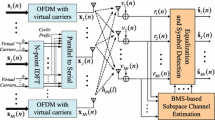Abstract
In this paper, the applicability of the subspace-based blind adaptive detector in multiple access time-hopping ultra-wideband (TH-UWB) systems is investigated. The subspace-based blind adaptive detector is highly sensitive to sudden changes in a time-varying channel. The sudden changes in such an environment result in significant performance degradation of the adaptive detector and slow convergence to the steady state. To overcome this shortcoming, we propose a simple decision mechanism, called “decision timing instant” (DTI), to detect the sudden changes. The results show that the subspace-based blind adaptive detector with DTI mechanism can improve both the system performance and convergence speed over time-varying multi-path channels.
Similar content being viewed by others
References
Win, M. Z., & Scholtz, R. A. (1998). Impulse radio: How it works. IEEE Communications Letters, 2(2), 36–38.
Win, M. Z., & Scholtz, R. A. (2000). Ultra-wide bandwidth time-hopping spread-spectrum impulse radio for wireless multiple-access communications. IEEE Transactions on Communications, 48(4), 679–691.
Cuomo, F., Martello, C., Baiocchi, A., & Capriotti, F. (2002). Radio resource sharing for ad-hoc networking with UWB. IEEE Journal on Selected Areas in Communications, 20(9), 1722–1732.
Fishler, E., & Poor, H. V. (2005). On the tradeoff between two types of processing gains. IEEE Transactions on Communications, 53(10), 1744–1753.
Gezici, S., Kobayashi, H., & Poor, H. V. (2004). A comparative study of pulse combining schemes for impulse radio UWB systems. In Proceeding of IEEE Sarnoff symposium (pp. 7–10), April 2004.
Cheng, C. H., Lin, J. Y., & Wen, J. H. (2009). O3-based linear decorrelating detector for asynchronous UWB systems over multipath fading channels. AEÜ. International Journal of Electronics and Communications, 63(3), 158–167.
Han, S., Oh, E., Han, M., Woo, C., & Hong, D. (2009). Performance analysis of multistage interference cancellation for asynchronous TH-UWB systems in multipath fading channels. IEEE Transactions on Vehicular Technology, 58(3), 1177–1189.
Cheng, C. H., Wen, J. H., Chen, Y. F., & Lin, J. Y. (2008). A robust interference cancellation technique for DS-UWB systems using fuzzy step size LMS algorithm. European Transactions on Telecommunications, 19(2), 207–217.
Ahmed, Q. Z., & Yang, L. L. (2010). Reduced-rank adaptive multiuser detection in hybrid direct-sequence time-hopping ultrawide bandwidth systems. IEEE Transactions on Wireless Communications, 9(1), 156–167.
Xu, Z., Liu, P., & Tang, J. (2005). A subspace approach to blind multiuser detection for ultra-wideband communication systems. EURASIP Journal on Applied Signal Processing, 2005(3), 413–425.
Wang, F., & Xu, C. Q. (2009). Two-stage blind adaptive multiuser detection algorithm for DS-CDMA UWB in ISI channels. In Proceeding of IEEE wireless communications & signal processing (pp. 1–5), November 2009.
Zhang, D., Wang, K., & Zhang, X. (2010). Blind adaptive affine projection algorithm-based multiuser detector over a multipath fading channel. Signal Processing, 90(6), 2102–2106.
Wang, X., & Poor, H. V. (1998). Blind multiuser detection: a subspace approach. IEEE Transactions on Information Theory, 44(2), 677–690.
Wang, X., & Poor, H. V. (1998). Blind equalization and multiuser detection in dispersive CDMA channels. IEEE Transactions on Communications, 46(1), 91–103.
Honig, M., Madhow, U., & Verdú, S. (1995). Blind adaptive multiuser detection. IEEE Transactions on Information Theory, 41(4), 944–960.
Xu, Z., Liu, P., & Wang, X. (2004). Blind multiuser detection: from MOE to subspace methods. IEEE Transactions on Signal Processing, 52(2), 510–524.
Wen, J. H., & Wen, C. K. (2001). Adaptive recursive algorithm for complementary subspace based blind multiuser detection. IEEE Transactions on Circuits and Systems. 2, Analog and Digital Signal Processing, 48(12), 1132–1136.
Buzzi, S., Lops, M., & Poor, H. V. (2003). Blind adaptive joint multiuser detection and equalization in dispersive differentially encoded CDMA channels. IEEE Transactions on Signal Processing, 51(7), 1880–1893.
Yang, B. (1995). Projection approximation subspace tracking. IEEE Transactions on Signal Processing, 43(1), 95–107.
Foerster, J., et al. (2003). Channel modeling sub-committee report final. IEEE 802.15 Working Group for Wireless Personal Area Networks (WPANs), IEEE P802.15-02/490r1-SG3a.
Molisch, A. F., Foerster, J. R., & Pendergrass, M. (2003). Channel models for ultrawideband personal area networks. IEEE Personal Communications, 10(6), 14–21.
Madhow, U., & Honig, M. (1994). MMSE interference suppression for direct-sequence spread-spectrum CDMA. IEEE Transactions on Communications, 42, 3178–3188.
Strobach, P. (1997). Bi-iteration SVD subspace tracking algorithms. IEEE Transactions on Signal Processing, 45(5), 1222–1240.
Miao, Y., & Hua, Y. (1998). Fast subspace tracking and neural network learning by a novel information criterion. IEEE Transactions on Signal Processing, 46(7), 1967–1979.
Leon-Garcia, A. (1994). Probability and random processes for electrical engineering (2nd ed.). Reading: Addison-Wesley.
Poor, H. V., & Verdu, S. (1997). Probability of error in MMSE multiuser detection. IEEE Transactions on Information Theory, 43, 868–871.
Author information
Authors and Affiliations
Corresponding author
Rights and permissions
About this article
Cite this article
Cheng, CH. A subspace-based blind detector with rapid channel tracking structure for TH-UWB systems over time-varying multi-path channels. Telecommun Syst 52, 413–422 (2013). https://doi.org/10.1007/s11235-011-9446-z
Published:
Issue Date:
DOI: https://doi.org/10.1007/s11235-011-9446-z




